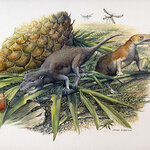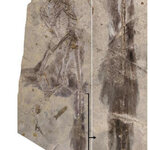Paleontology

The Taung Child, a hominin discovered in South Africa 90 years ago by Wits University Professor Raymond Dart, has been studied using the Wits University Microfocus X-ray Computed Tomography (CT) facility and the results cast doubt on theories that Australopithecus africanus shows the same cranial adaptations found in modern human infants and toddlers.
Instead it seems to disprove current support for the idea that this early hominin shows infant brain development in the prefrontal region similar to that of modern humans.
The Taung Child was the first australopith and has importance in the…

For most people, the Jurassic period conjures up images of huge dinosaurs chomping their way through lush vegetation and each other.
But mammals and their immediate ancestors were also around 201 to 145 million years ago, just not as spectacular as we are now.
Early Jurassic mammals were thought to have been confined to the ecological margins, eating whatever insects they could find. However, this was also the time when new mammal characteristics – such as better hearing and teeth capable of precise chewing – were developing. So, if the earliest mammals were all small generalized…

Scientists have reported discovery of a new ancient pterosaur species called Caiuajara dobruskii - and the bones of 47 members to go with it. Caiuajara dobruskii lived during the Cretaceous in southern Brazil, according to the paper.
There may be more among the hundreds of bones. The pterosaur bone bed in the interdunal lake deposit of a Cretaceous desert contains at least 47 individuals, with wing spans of between 0.65 and 2.35 meter. Caiuajara dobruskii is the southermost occurrence of the edentulous clade Tapejaridae (Tapejarinae, Pterodactyloidea) recovered so far.
Caiuajara dobruskii is…

A comparison of Baltic Sea region amber with amber from Asia could be significant - rather than being found just in Mecklenburg, Poland or Belarus, European species have been found almost 10,000 kilometers away in Fushun, even though Europe and Asia were divided by the Strait of Turgay, a wide arm of the ocean, 50 million years ago.
The pieces from the Baltic region are younger than the ones from Fushun and the assumption has been that this body of saltwater prevented species migrations between the continents.
Golden coffin: An insect is trapped in Fushun amber.…

Paleontologists have discovered the exquisitely preserved brain in the fossil of one of the world's first known predators that lived in the Lower Cambrian, about 520 million years ago. The discovery revealed a brain that is surprisingly simple and less complex than those known from fossils of some of the animal's prey.
The find for the first time identifies the fossilized brain of what are considered the top predators of their time, a group of animals known as anomalocaridids, which translates to "abnormal shrimp."
Long extinct, these fierce-looking arthropods were first discovered as…

A new raptorial dinosaur fossil with exceptionally long feathers, including a long feathered tail, has led the authors to believe they were instrumental for decreasing descent speed and assuring safe landings.
Changyuraptor yangi is a 125-million-year-old dinosaur found in the Liaoning Province of northeastern China. The location has seen a surge of discoveries in feathered dinosaurs over the last decade. The newly discovered, remarkably preserved dinosaur sports a full set of feathers cloaking its entire body, including the extra-long tail feathers.
“At a foot in length, the…
Much of what we know about Öetzi - the 'Tyrolean Iceman’ – such as what he looked like and that he suffered from lactose intolerance, stems from a tiny bone sample which allowed the decoding of his genetic make-up.
A team of scientists have examined the part of the sample consisting of non-human DNA. In the DNA mixture, they detected a sizeable presence of a particular bacterium: Treponema denticola, an opportunistic pathogen involved in the development of periodontitis. The finding supports the computer tomography based diagnosis that the Iceman suffered from periodontitis.
What is also…

One of the first predators on land, a 410-million-year-old arachnid, has been virtually brought back to life. Paleontologists used exceptionally preserved fossils from the Natural History Museum in London to create the video showing the most likely walking gait of the animal.
The scientists used the fossils - thin slices of rock showing the animal's cross-section - to deduce the range of motion in the limbs of this ancient, extinct early relative of the spiders. From this, and comparisons to living arachnids, the researchers used the open source computer graphic program …

Paleontologists of Ludwig-Maximilians-Universitaet in Munich studying a new specimen of Archaeopteryx have found previously unknown features of the plumage, which shed light on the original function of feathers and their recruitment for flight.
A century and a half after its discovery and a mere 150 million years or so since it took to the air, Archaeopteryx still has surprises in store: The eleventh specimen of the iconic "basal bird" so far discovered turns out to have the best preserved plumage of all, permitting detailed comparisons to be made with other feathered dinosaurs.
The…

Researchers have reported the discovery of 46 ophthalmosaurid ichthyosaurs (marine reptiles) in the vicinity of the Tyndall Glacier in the Torres del Paine National Park of southern Chile. Among them are numerous articulated and virtually complete skeletons of adults, pregnant females, and juveniles.
Preservation is excellent and occasionally includes soft tissue and embryos. The skeletons are associated with ammonites, belemnites, inoceramid bivalves, and fishes as well as numerous plant remains.
The enormous concentration of ichthyosaurs is unique for Chile and South America…